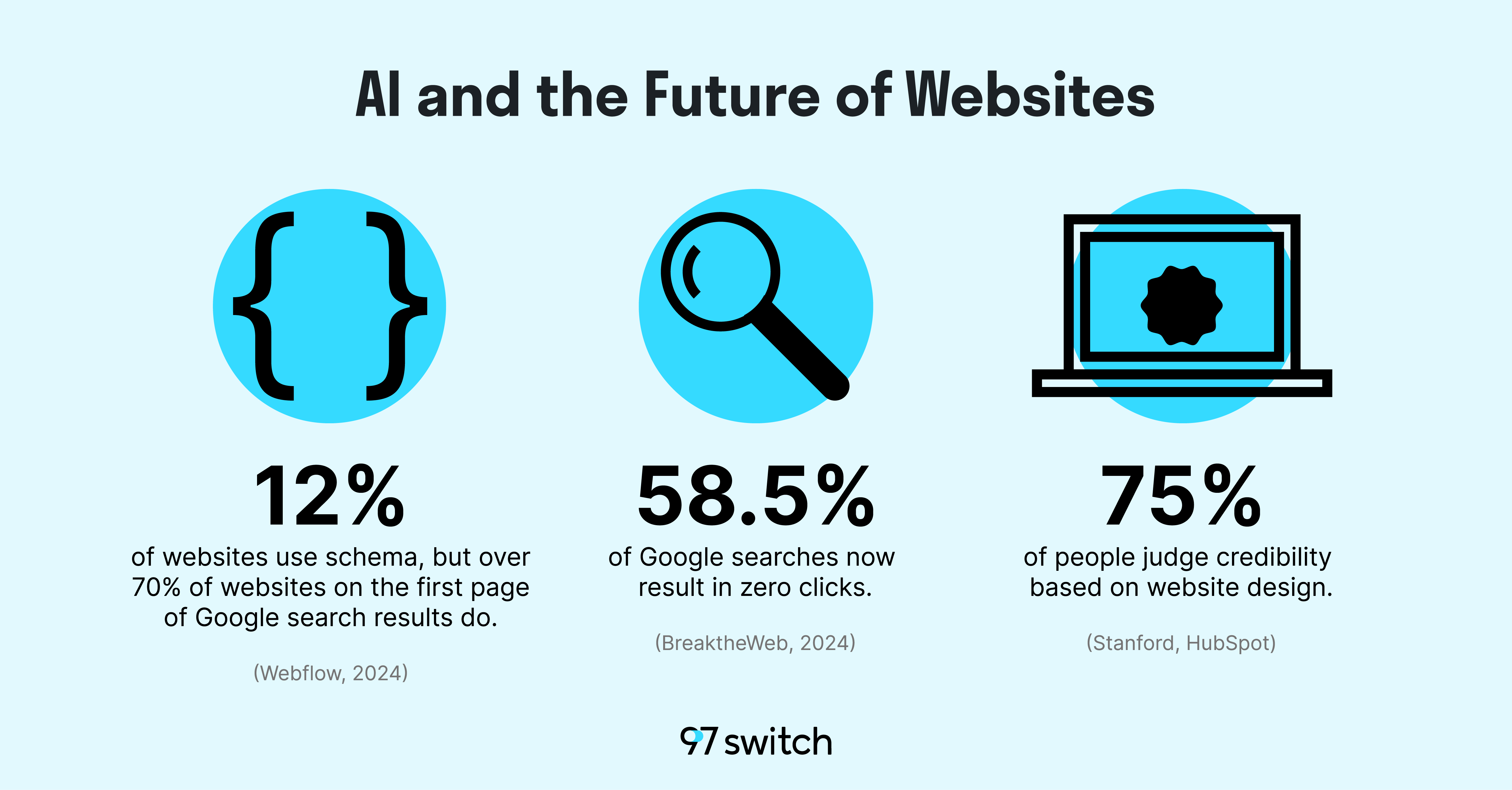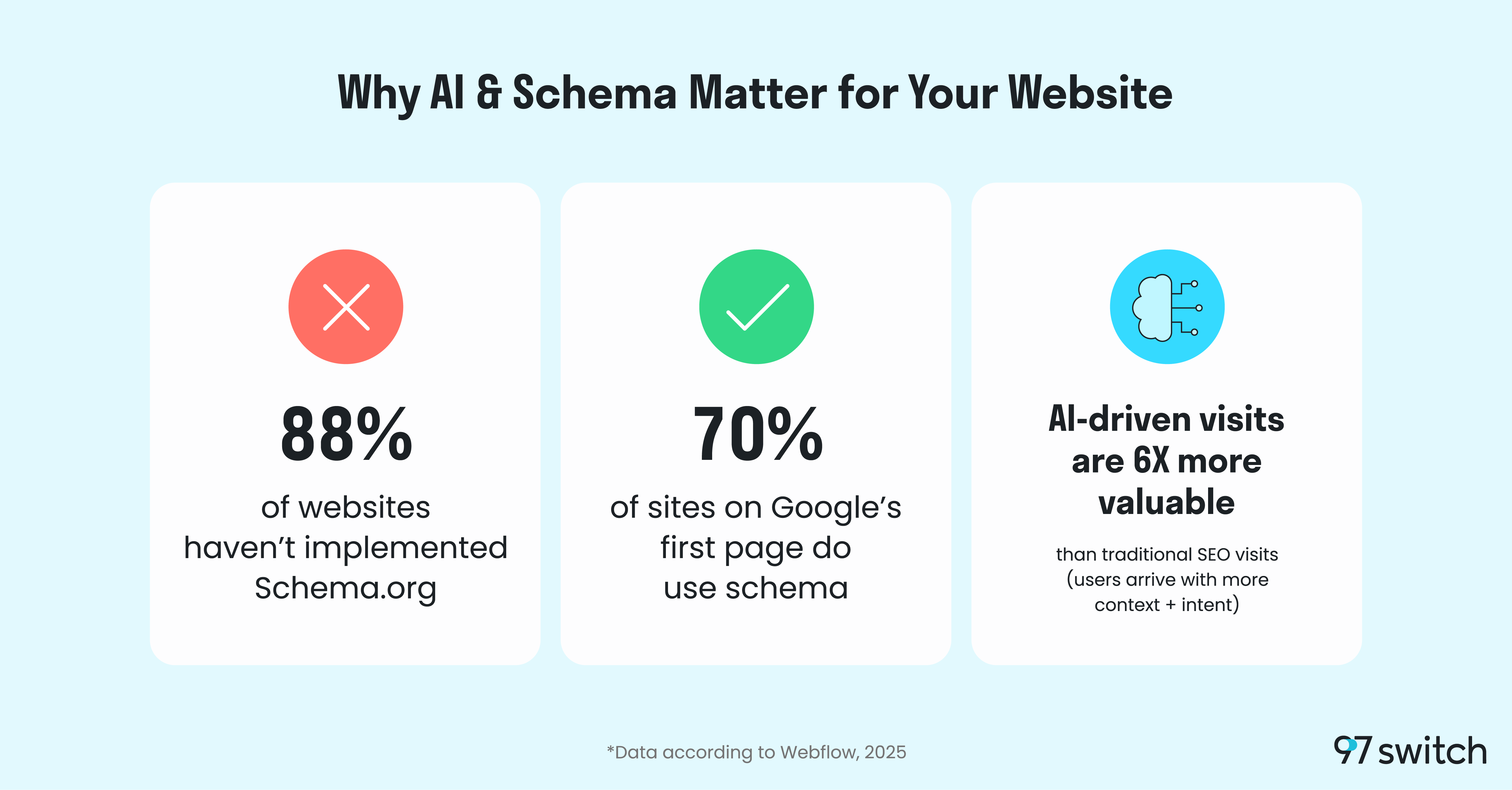Over the past few years, how people find and interact with websites has changed more than ever before. Artificial intelligence — from ChatGPT Browse to Google’s AI Overviews and Perplexity — is rewriting the rules of digital discovery.
But one thing hasn’t changed: people still visit websites to decide whether they trust your brand.
Modern websites need to perform on both fronts. They should delight people with great design and storytelling — while being structured and readable for AI systems that now interpret and rank online content.
If your site hasn’t had a major update in a few years, here’s what’s changed, why it matters, and how to prepare for 2026.
The Web Is Evolving — AI Is Now a Gatekeeper
People don’t always “click” like they used to.
- 58.5% of Google searches now result in zero clicks (BreaktheWeb, 2024) — meaning many users get their answers directly from AI-generated summaries.
- At the same time, AI tools like ChatGPT, Gemini, and Perplexity now pull from websites to create conversational answers, not just search results.
That means your content must not only rank well but also be understood by AI systems. The better AI can interpret your site, the more likely your brand appears in summaries, citations, and recommendations.
Structure Matters More Than Ever
AI systems don’t see your website the way humans do. They don’t “read” your design — they read your data.
That’s where structured data (schema) comes in. Schema tells AI and search engines what your content means, not just what it says.
- Only 12% of websites use schema, but over 70% of websites on Google’s first page do (Webflow, 2024).
- Schema is especially critical for local businesses, events, products, and services — helping your site appear in AI summaries, voice results, and enhanced listings.
Adding schema is like adding subtitles for machines — it ensures your message gets through clearly.
First Impressions Still Belong to Humans
Even with AI intermediaries, people still visit websites — and they judge them quickly.
- 75% of users judge a company’s credibility based on website design (Stanford, HubSpot).
Outdated visuals, slow load times, or clunky mobile experiences all signal that your brand is behind the curve — even if your content is strong.
A modern, trustworthy website doesn’t just look good — it feels easy. It tells your story clearly, loads fast, and guides people naturally to take action.
How to Modernize Your Website for 2026
Here’s a simple roadmap to bring your website up to speed:
- Step 1: Audit Your Site’s Structure – Check for schema markup, broken links, missing metadata, and poor heading hierarchy. These all affect how AI and search engines interpret your site.
- Step 2: Simplify Your Messaging – Rewrite your core pages to focus on user intent and clarity. Speak to the problems your audience is solving — not just your services.
- Step 3: Refresh the Design – Update typography, layout, and imagery for better readability and performance. Modern sites use generous white space, fast animations, and accessible color contrast.
- Step 4: Improve Performance and Accessibility – Run speed tests, optimize for mobile, and ensure your content meets accessibility standards — all factors that AI systems and people alike reward.
- Step 5: Future-Proof Your CMS – Consider flexible platforms like Webflow or headless CMS options that can evolve with AI integrations and analytics tools.
Keep the Human Touch
AI can help users find you — but only great human-centered design keeps them engaged.
As automation increases, design and storytelling become even more critical differentiators. The most successful brands will use AI to handle the technical layer — and invest their creativity in connecting emotionally with real people.
FAQ: Modernizing Your Website for the AI Era
Q: Does AI mean SEO is dead?
No — but SEO is evolving. Traditional keyword optimization is giving way to entity-based optimization and structured data. It’s about making your content understandable to both humans and AI.
Q: How often should I update my website?
If your site hasn’t had a significant refresh in 3–4 years, it’s likely missing current design, speed, and AI-readiness standards.
Q: What’s the fastest way to make my site more AI-friendly?
Start by adding structured data (schema) to key pages, improving heading structure, and ensuring all images and links are properly labeled.
Q: Can AI design my website for me?
AI tools can speed up design and testing, but strategy and storytelling still require a human touch. AI assists — it doesn’t replace creative direction.
Q: How can I tell if my site is outdated?
If it loads slowly, looks cramped on mobile, or doesn’t reflect your brand story clearly, it’s time to modernize.
—----------------------
The next evolution of the web won’t be fully human — or fully machine. It will be a partnership.
The brands that win in 2026 will understand both audiences — designing websites that speak clearly to AI while inspiring real people.
At 97 Switch, we help businesses bridge that gap — building websites that perform, persuade, and prepare for what’s next.
About the Author
Jeremy Greenberg is the founder of 97 Switch, an award-winning digital marketing agency that helps mid-market and enterprise companies turn digital strategy into measurable growth through premium marketing, modern technology, and trusted partnerships. He works with organizations in real estate, hospitality, SaaS, and beyond to align brand, marketing, and technology into cohesive, results-driven experiences. Recognized by Clutch, UpCity, and industry peers for its care-driven approach, 97 Switch focuses on building strong foundations, executing with precision, and continually optimizing through data and insights. Based in Portland, Jeremy enjoys running and exploring local trails when he’s not helping companies grow through digital innovation.





